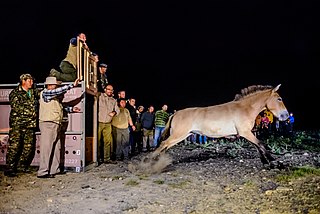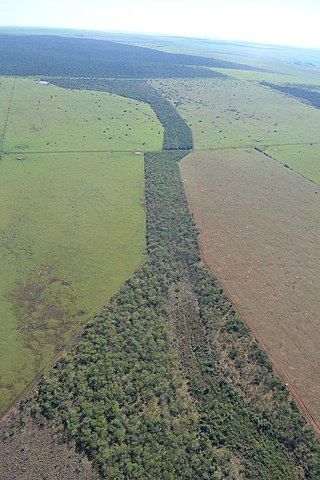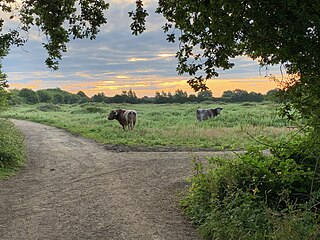Related Research Articles

The wolf, also known as the gray wolf or grey wolf, is a large canine native to Eurasia and North America. More than thirty subspecies of Canis lupus have been recognized, including the dog and dingo, though gray wolves, as popularly understood, only comprise naturally-occurring wild subspecies. The wolf is the largest extant member of the family Canidae, and is further distinguished from other Canis species by its less pointed ears and muzzle, as well as a shorter torso and a longer tail. The wolf is nonetheless related closely enough to smaller Canis species, such as the coyote and the golden jackal, to produce fertile hybrids with them. The wolf's fur is usually mottled white, brown, gray, and black, although subspecies in the arctic region may be nearly all white.
This is an index of conservation topics. It is an alphabetical index of articles relating to conservation biology and conservation of the natural environment.

Habitat conservation is a management practice that seeks to conserve, protect and restore habitats and prevent species extinction, fragmentation or reduction in range. It is a priority of many groups that cannot be easily characterized in terms of any one ideology.

Species reintroduction is the deliberate release of a species into the wild, from captivity or other areas where the organism is capable of survival. The goal of species reintroduction is to establish a healthy, genetically diverse, self-sustaining population to an area where it has been extirpated, or to augment an existing population. Species that may be eligible for reintroduction are typically threatened or endangered in the wild. However, reintroduction of a species can also be for pest control; for example, wolves being reintroduced to a wild area to curb an overpopulation of deer. Because reintroduction may involve returning native species to localities where they had been extirpated, some prefer the term "reestablishment".

Wildlife crossings are structures that allow animals to cross human-made barriers safely. Wildlife crossings may include underpass tunnels or wildlife tunnels, viaducts, and overpasses or green bridges ; amphibian tunnels; fish ladders; canopy bridges ; tunnels and culverts ; and green roofs.

An apex predator, also known as a top predator, is a predator at the top of a food chain, without natural predators of its own.
Rewilding is a form of ecological restoration that returns habitats to their natural states.

The short-eared dog, also known as the short-eared zorro or small-eared dog, is a unique and elusive canid species endemic to the Amazonian basin. This is the only species assigned to the genus Atelocynus.
Yellowstone to Yukon Conservation Initiative or Y2Y is a transboundary Canada–United States not-for-profit organization that aims to connect and protect the 2,000 miles Yellowstone-to-Yukon region. Its mission proposes to maintain and restore habitat integrity and connectivity along the spine of North America's Rocky Mountains stretching from the Greater Yellowstone ecosystem to Canada's Yukon Territory. It is the only organization dedicated to securing the long-term ecological health of the region.

The Mexican wolf, also known as the lobo, is a subspecies of gray wolf native to southeastern Arizona and southern New Mexico in the United States, and northern Mexico. It once also ranged into western Texas. It is the smallest of North America's gray wolves, and is similar to the Great Plains wolf, though it is distinguished by its smaller, narrower skull and its darker pelt, which is yellowish-gray and heavily clouded with black over the back and tail. Its ancestors were likely the first gray wolves to enter North America after the extinction of the Beringian wolf, as indicated by its southern range and basal physical and genetic characteristics.

Save China's Tigers (SCT) is an international charitable foundation based in Hong Kong, the United States, and the United Kingdom that aims to save the big cats of China from extinction. It focuses on the Chinese tigers. It also has other branches in Mainland China and South Africa.
The Boreal Forest Conservation Framework, was adopted December 1, 2003 to protect the Canadian boreal forest. The vision set out in the Framework is "to sustain the ecological and cultural integrity of the Canadian boreal region, in perpetuity." Its goal is to conserve the boreal region by: "protecting at least 50% of the region in a network of large interconnected protected areas, and supporting sustainable communities through world-leading ecosystem-based resource management practices and leading edge stewardship practices in the remaining landscape."

Pleistocene rewilding is the advocacy of the reintroduction of extant Pleistocene megafauna, or the close ecological equivalents of extinct megafauna. It is an extension of the conservation practice of rewilding, which aims to restore functioning, self-sustaining ecosystems through practices that may include species reintroductions.

A wildlife corridor, habitat corridor, or green corridor is an area of habitat connecting wildlife populations separated by human activities or structures. This allows an exchange of individuals between populations, which may help prevent the negative effects of inbreeding and reduced genetic diversity that often occur within isolated populations. Corridors may also help facilitate the re-establishment of populations that have been reduced or eliminated due to random events. This may moderate some of the worst effects of habitat fragmentation, whereas urbanization can split up habitat areas, causing animals to lose both their natural habitat and the ability to move between regions to access resources. Habitat fragmentation due to human development is an ever-increasing threat to biodiversity, and habitat corridors serve to manage its effects.

The Wildlands Network was created in 1991 to stem the tide of species extinctions that was being recorded across North America. Evidence that such extinctions were often exacerbated by a lack of habitat connectivity between existing protected areas resulted in the organization’s adoption of a primary mission focused on scientific and strategic support for creation of “networks of people protecting networks of connected wildlands.”

Rewilding is a form of ecological restoration aimed at increasing biodiversity and restoring natural processes. It differs from other forms of ecological restoration in that rewilding aspires to reduce human influence on ecosystems. It is also distinct from other forms of restoration in that, while it places emphasis on recovering geographically specific sets of ecological interactions and functions that would have maintained ecosystems prior to human influence, rewilding is open to novel or emerging ecosystems which encompass new species and new interactions.
Rewilding Europe is a non-profit organization based in Nijmegen, the Netherlands, dedicated to create rewilded landscapes throughout Europe. The group's efforts have contributed to increase the stock of previously endangered species such as the European bison and the Iberian lynx.
Reed F. Noss, a conservation biologist since the beginning of the field in the early 1980s, is a writer, photographer, and speaker, retired in 2017 as Provost's Distinguished Research Professor, Pegasus Professor, and Davis-Shine Professor at the University of Central Florida. He is President and Chief Scientist for the Florida Institute for Conservation Science, Chief Science Advisor for the Southeastern Grasslands Initiative, and Chief Science Advisor for the Endangered Ecosystems Alliance. Noss' published work consists of over 350 published or in press scientific articles, book chapters, and major reports and eight published books, with another book in preparation.

Yadvendradev Vikramsinh Jhala is an Indian scientist and conservationist who recently ended his tenure as the Dean at the Wildlife Institute of India in Dehradun.

Sea rewilding is an area of environmental conservation activity which focuses on rewilding, restoring ocean life and returning seas to a more natural state. Sea rewilding projects operate around the world, working to repopulate a wide range of organisms, including giant clams, sharks, skates, sea sturgeons, and many other species. Rewilding marine and coastal ecosystems offer potential ways to mitigate climate change and sequester carbon. Sea rewilding projects are currently less common than those focusing on rewilding land, and seas are under increasing stress from the blue economy – commercial activities which further stress the marine environment. Rewilding projects held near coastal communities can economically benefit local businesses as well as individuals and communities a whole.
References
- ↑ Foreman, Dave, "Rewilding North America: A Vision For Conservation In The 21st Century" (2004) (Paperback) Publisher: Island Press. ISBN 1-55963-061-2 ISBN 978-1-55963-061-0.
- ↑ Team, G. R. A. (2022-09-28). "Dave Foreman - Remembering a Father Tree". The Global Rewilding Alliance. Retrieved 2024-04-27.
- ↑ Website of the Rewilding Institute.
- ↑ "Rewilding Institute - GuideStar Profile". www.guidestar.org. Retrieved 2024-04-27.
- ↑ Chen, Michelle, "Wolves’ Removal from Endangered List a Disputed ‘Success’." The New Standard, February 6, 2007. Retrieved February 15, 2007.
- ↑ "The Rewilding Institute." Wisconsin Public Radio
- ↑ Gomez, Matt, "Project to Help I-40 Safety." Mountain View Telegraph, September 14, 2006. From Albuquerque Journal online edition.